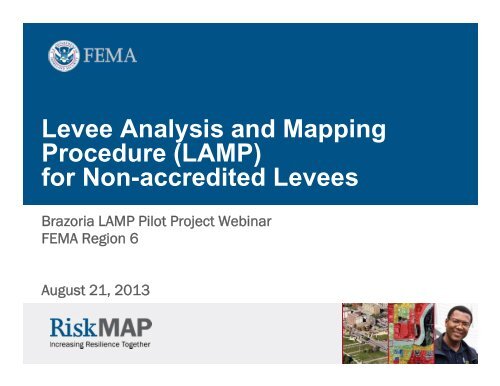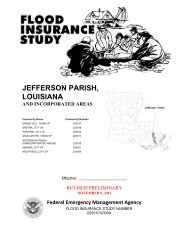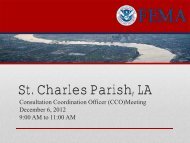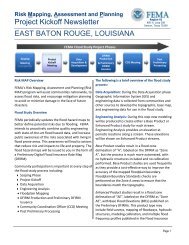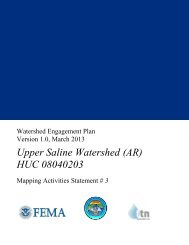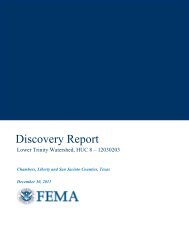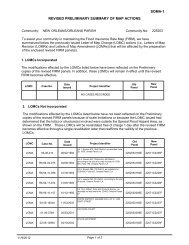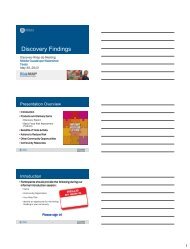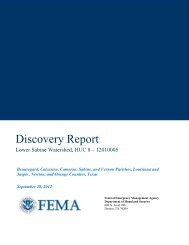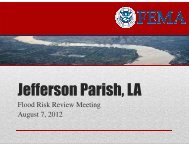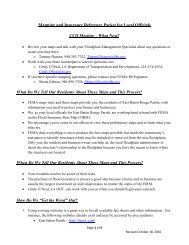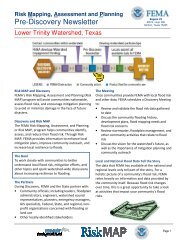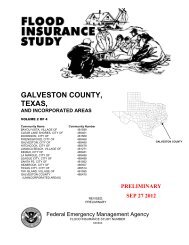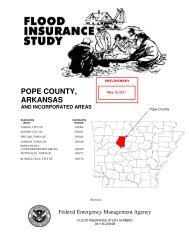Levee Analysis and Mapping Procedure (LAMP) for ... - RiskMAP6
Levee Analysis and Mapping Procedure (LAMP) for ... - RiskMAP6
Levee Analysis and Mapping Procedure (LAMP) for ... - RiskMAP6
You also want an ePaper? Increase the reach of your titles
YUMPU automatically turns print PDFs into web optimized ePapers that Google loves.
<strong>Levee</strong> <strong>Analysis</strong> <strong>and</strong> <strong>Mapping</strong><br />
<strong>Procedure</strong> (<strong>LAMP</strong>)<br />
<strong>for</strong> Non-accredited <strong>Levee</strong>s<br />
Brazoria <strong>LAMP</strong> Pilot Project Webinar<br />
FEMA Region 6<br />
August 21, 2013
Webinar Topics<br />
• Overview of <strong>Levee</strong> <strong>Analysis</strong> <strong>and</strong> <strong>Mapping</strong> Process<br />
(<strong>LAMP</strong>) <strong>for</strong> Non-accredited <strong>Levee</strong>s Approach<br />
• Local <strong>Levee</strong> Partnership Teams (LLPT)<br />
• Anticipated Issues Specific To Brazoria County<br />
• Comments <strong>and</strong> Concerns on Approach<br />
• Schedule<br />
• Meet <strong>and</strong> Greet<br />
2
The <strong>LAMP</strong> Process<br />
Phase 1<br />
Phase 2<br />
Phase 3<br />
3
Overview of <strong>LAMP</strong> Approach<br />
There are five procedures detailed in<br />
the <strong>LAMP</strong> Final Approach Document.<br />
• Natural Valley<br />
• Sound Reach<br />
• Freeboard Deficient<br />
• Overtopping<br />
• Structural-Based Inundation<br />
A system can be broken up into<br />
multiple reaches in order to analyze<br />
the flood risk in its vicinity.<br />
1 System<br />
↓<br />
Multiple<br />
Reaches<br />
4
Natural Valley <strong>Procedure</strong><br />
• Basic analysis to be applied to all levee systems, <strong>and</strong>/or<br />
individual reaches (procedure possible with minimal data)<br />
• This procedure refers to the river channel <strong>and</strong> floodplain of<br />
a river system, or coastal area, prior to the addition of<br />
flood control structures (e.g. levees)<br />
• No additional<br />
data needs or<br />
requirements<br />
<strong>for</strong> preparation<br />
of analysis<br />
5
Sound Reach <strong>Procedure</strong><br />
For a levee reach designed, constructed, <strong>and</strong> maintained to<br />
withst<strong>and</strong> <strong>and</strong> reduce the flood hazard posed by the base<br />
(one-percent-annual-chance) flood.<br />
• No levee reach-specific modeling<br />
necessary<br />
• Zone D l<strong>and</strong>ward of the reach<br />
• Interior drainage may map some<br />
flood hazard on the l<strong>and</strong>ward side<br />
• Specified reach meets all 65.10<br />
requirements <strong>and</strong> each is<br />
documented<br />
6
Freeboard Deficient <strong>Procedure</strong><br />
For levee reaches that cannot meet the freeboard regulatory<br />
requirements in 44 CFR 65.10 (freeboard helps to account <strong>for</strong><br />
uncertainty in design <strong>and</strong> the base flood).<br />
• Natural Valley<br />
Approach is used to<br />
map l<strong>and</strong>ward risk<br />
• Zone D l<strong>and</strong>ward of<br />
the reach<br />
• <strong>Levee</strong> crest must be<br />
higher than the<br />
calculated BFE <strong>for</strong> this<br />
method to be suitable<br />
7
Overtopping <strong>Procedure</strong><br />
• Appropriate <strong>for</strong> levee reaches that are known to overtop<br />
during the one-percent-annual chance flood.<br />
• The BFE is calculated to exceed the height of the levee<br />
crest at a minimum of one location along the levee’s reach<br />
length).<br />
• Structure should be<br />
designed <strong>for</strong> overtopping<br />
• Structural requirements<br />
are met <strong>and</strong><br />
documented<br />
• <strong>Levee</strong> modeled as a<br />
lateral weir<br />
8
Structural-Based Inundation<br />
<strong>Procedure</strong><br />
For a levee reach where evaluation reports <strong>and</strong>/or historic<br />
per<strong>for</strong>mance indicate structural issues.<br />
• <strong>Levee</strong> reports <strong>and</strong><br />
historical<br />
in<strong>for</strong>mation will<br />
in<strong>for</strong>m the modeling<br />
ef<strong>for</strong>t <strong>for</strong> this<br />
scenario.<br />
• Need to identify<br />
the locations of<br />
structural issues &<br />
determine failure<br />
scenarios<br />
9
Definition of Reach<br />
Barely overtops & is armored:<br />
community chooses to do extra<br />
evaluation <strong>for</strong> overtopping<br />
These areas are overtopped<br />
Recent structural analysis completed<br />
Operated <strong>and</strong> Maintained<br />
Good Survey In<strong>for</strong>mation<br />
Overtops but not armored<br />
Has required freeboard<br />
Don’t know anything about<br />
Not maintained<br />
No owner<br />
No structural analysis<br />
10
Data Available Determines<br />
Which <strong>LAMP</strong> <strong>Procedure</strong> Is Used<br />
Reach overtops, armoring present,<br />
community provides additional<br />
in<strong>for</strong>mation <strong>for</strong> evaluation of levee<br />
reach<br />
Overtopping <strong>Procedure</strong><br />
Reach overtops, no armoring<br />
present, vegetation <strong>and</strong> s<strong>and</strong><br />
boils present<br />
Structural-Based Inundation <strong>Procedure</strong><br />
Meets all requirements<br />
outlined in 44CFR65.10,<br />
community provided<br />
documentation noting all<br />
requisites are met<br />
Sound Reach <strong>Procedure</strong><br />
Not maintained, No owner,<br />
No data provided or<br />
available<br />
Natural Valley <strong>Procedure</strong><br />
11
<strong>Mapping</strong> the Results<br />
If ONLY Natural Valley <strong>Procedure</strong> is Used<br />
• In the case that the Natural Valley <strong>Analysis</strong> is selected <strong>and</strong><br />
utilized <strong>for</strong> the ENTIRE levee system.<br />
• Then only Natural Valley analysis/mapping ef<strong>for</strong>t will be<br />
per<strong>for</strong>med<br />
• The resultant floodplain will be<br />
depicted as a Special Flood<br />
Hazard Area<br />
(SFHA)<br />
(Zone A, Zone AE,<br />
Zone AO, Zone AH)<br />
Special Flood<br />
Hazard Area (SFHA)<br />
ONLY<br />
Natural Valley<br />
<strong>Procedure</strong><br />
Used<br />
12
<strong>Mapping</strong> the Results<br />
Composite Map - Layer One (Natural Valley)<br />
• If other analysis procedures are used, the Natural Valley<br />
<strong>Analysis</strong> will be depicted as Zone D.<br />
• Other analysis will be layered on top of these results to build<br />
the composite floodplain<br />
Zone D:<br />
Natural Valley <strong>Procedure</strong><br />
13
<strong>Mapping</strong> the Results<br />
Composite Map - Layer Two (Interior Drainage)<br />
• If system includes drainage features, pump stations or other<br />
drainage facilities, these areas will be analyzed <strong>and</strong> their 1%<br />
annual chance flood zone will be determined <strong>and</strong> added to<br />
the mapping (Zone A, Zone AE, Zone AO, Zone AH)<br />
14
<strong>Mapping</strong> the Results<br />
Composite Map - Layer Three (L<strong>and</strong>ward Hazard)<br />
• System was modeled with Overtopping <strong>and</strong> Structural Based<br />
Inundation <strong>Procedure</strong>s<br />
• These areas are mapped <strong>and</strong> added to the composite mapping<br />
as Special Flood Hazard Areas (Zone A/AE, Zone AO/AH)<br />
Overtopping <strong>Procedure</strong><br />
Structural-Based<br />
Inundation<br />
<strong>Procedure</strong><br />
15
<strong>Mapping</strong> the Results<br />
Composite Map - Layer Four (Flooding Source)<br />
• Finally, the flooding source analysis results will be added to the<br />
composite map to finalize the composite mapping.<br />
• The analysis <strong>for</strong> the open coast or the riverine flood source will<br />
be based on the calculated Base Flood Elevations (BFEs) <strong>for</strong><br />
the riverward (seaward) side of the levee system.<br />
16
<strong>Mapping</strong> the Results<br />
OR a Composite Map will be prepared<br />
If a series of procedures are<br />
used to determine the flood<br />
risk <strong>for</strong> a single levee<br />
system…<br />
- each reach analysis will be<br />
per<strong>for</strong>med<br />
- Each reach mapping ef<strong>for</strong>t will be<br />
prepared<br />
- And then a composite map will be<br />
created from the compilation of<br />
the resultant analysis of each<br />
procedure.<br />
17
Documentation of <strong>Levee</strong><br />
Condition<br />
• Appropriate analysis requires documentation of levee<br />
condition<br />
•Structural stability of levee<br />
•Elevation of levee<br />
•Armoring<br />
• FEMA has been instructed that it may not invest in:<br />
•Data required <strong>for</strong> levee accreditation<br />
•Data required <strong>for</strong> a determination of a levee system’s<br />
structural condition<br />
• Responsibility of levee owner<br />
18
The <strong>LAMP</strong> Process<br />
• Previous overviews available at www.riskmap6.com.<br />
• http://www.riskmap6.com/documents/Meeting_340/FINAL_<strong>LAMP</strong>InitiationWebinar-2013-<br />
08-09.pptx<br />
• Key elements of Phase 2 process going <strong>for</strong>ward:<br />
• Formation of LLPTs<br />
• Assessment of levees <strong>and</strong> appropriate analysis<br />
• Per<strong>for</strong>m approximate-level hydrologic <strong>and</strong><br />
hydraulic (H&H) analyses, review of results<br />
• Prepare <strong>Levee</strong> <strong>Analysis</strong><br />
<strong>and</strong> <strong>Mapping</strong> Plan<br />
19
Local <strong>Levee</strong> Partnership Team<br />
(LLPT)<br />
• FEMA (<strong>and</strong> USACE where appropriate) will attend<br />
• Items <strong>for</strong> Local Communities to Consider:<br />
• Member with community decision making authority (or one who<br />
advises decision) is requested<br />
• Representation from geography <strong>and</strong> political jurisdictions within<br />
the system, make sure the levee owner is included<br />
• Community may want a technical participant to provide input<br />
(Engineering Department/Consultant)<br />
• Floodplain Management Staff<br />
• Others? (What other factors are important in your area)<br />
20
Local <strong>Levee</strong> Partnership Team<br />
(LLPT)<br />
• Meeting-Specific Objectives:<br />
• Important in<strong>for</strong>mation <strong>and</strong> data related to how the levee<br />
will be analyzed <strong>and</strong> mapped is obtained <strong>and</strong> considered.<br />
• LLPT members have an opportunity to explain the unique<br />
conditions related to their levee that will impact the<br />
analysis <strong>and</strong> mapping.<br />
• LLPT members comment on methods <strong>for</strong> levee reaches,<br />
analyses, <strong>and</strong> mapping within the allowable guidelines.<br />
• A reasonable schedule is developed <strong>for</strong> obtaining input or<br />
additional data.<br />
21
Local <strong>Levee</strong> Partnership Team<br />
(LLPT)<br />
• Level of ef<strong>for</strong>t will vary during this phase based on the<br />
complexity of the levee system in question.<br />
• Intention of this phase is to:<br />
• Coordination with stakeholders external to FEMA<br />
• Collect existing local data & system knowledge<br />
• Determine additional data communities plan to submit<br />
• Per<strong>for</strong>m approximate-level hydrologic <strong>and</strong><br />
hydraulic (H&H) analyses, review of results<br />
• Prepare <strong>Levee</strong> <strong>Analysis</strong><br />
<strong>and</strong> <strong>Mapping</strong> Plan<br />
22
Brazoria LLPTs<br />
• Two LLPTs in Brazoria County<br />
• Angleton Drainage District<br />
• Velasco Drainage District<br />
23
Getting to the LLPT Meeting(s):<br />
• Initial Pilot Meet <strong>and</strong> Greet<br />
•Week of September 17<br />
•Identified <strong>and</strong> potential LLPT members<br />
• Formation of LLPT<br />
•FEMA coordinating with USACE (where appropriate)<br />
•Communities should prepare a local participant list<br />
• Operational Guidance Release (slated <strong>for</strong> Mid September)<br />
• Face to Face LLPT (Technical Dive 1)<br />
24
Things You Can Do Now<br />
• Local communities should identify which systems<br />
will need to be reviewed <strong>for</strong> the application of <strong>LAMP</strong><br />
approach<br />
• Local communities should begin identifying<br />
available data <strong>and</strong> submitting it to their FEMA POC<br />
• Local communities should begin collection of all<br />
available data that could in<strong>for</strong>m the determination<br />
of which procedures may be applicable <strong>for</strong> your<br />
levee system<br />
25
For the Latest In<strong>for</strong>mation:<br />
• Visit FEMA’s <strong>LAMP</strong> webpage to access available<br />
in<strong>for</strong>mation <strong>for</strong> the <strong>Levee</strong> <strong>Analysis</strong> <strong>and</strong> <strong>Mapping</strong><br />
<strong>Procedure</strong>:<br />
http://www.fema.gov/<br />
final-levee-analysis-<strong>and</strong>-mapping-approach<br />
• Operational Guidance will be released <strong>and</strong> made<br />
available through this web page.<br />
26


